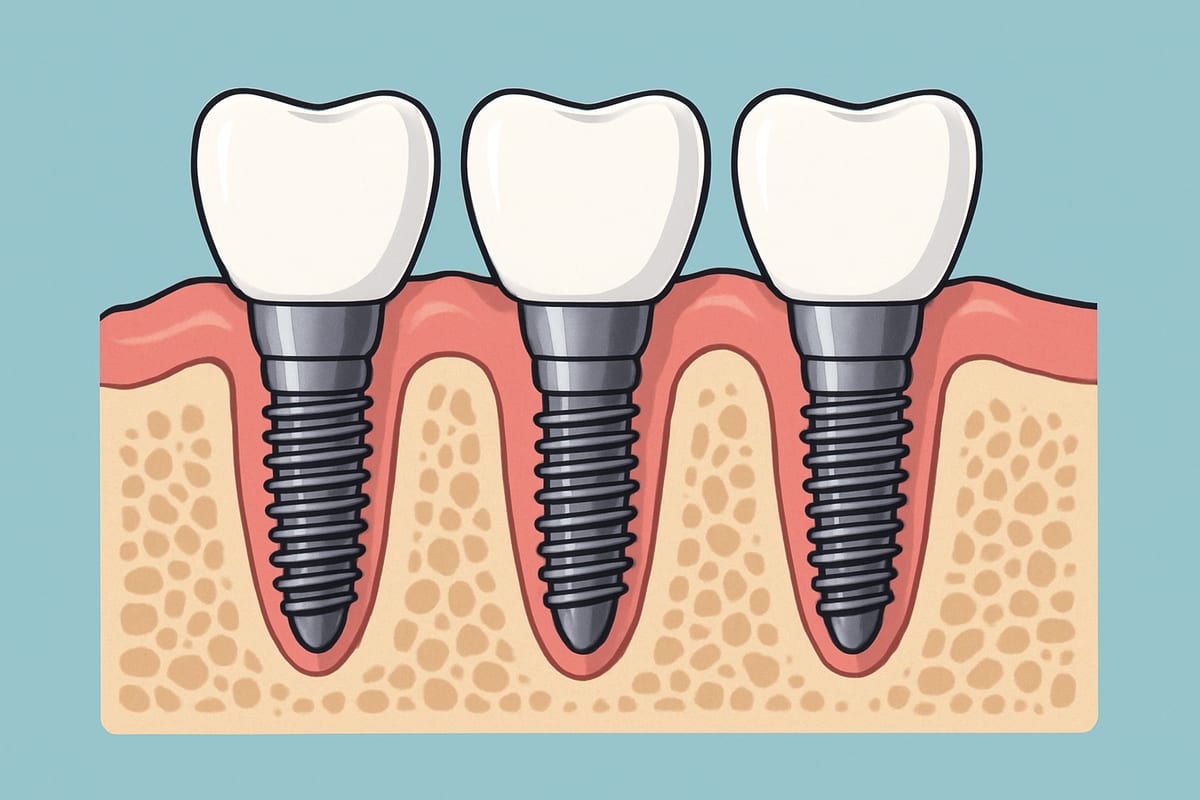Many patients ask: are periodontal implants different than dental implants? In plain terms, “periodontal implants” usually refers to dental implants placed for people who have or had periodontal disease. Knowing the difference matters because a history of periodontal disease changes how we plan treatment, control infection, and keep the implant healthy long term.
What are periodontal implants?
Periodontal implants are dental implants used to replace teeth lost or threatened by periodontal (gum) disease. The implant itself is the same type of fixture placed in the jaw to hold a crown, bridge, or denture. What makes them “periodontal” is the context: these cases focus on restoring support after gum and bone loss and preventing future infection around the implant.
Common goals with periodontal implants include:
- Stabilizing remaining teeth and bite
- Replacing teeth lost to gum disease
- Replacing lost bone and soft tissue support
- Providing a secure base for fixed or removable prosthetics
How periodontal implants differ from dental implants
Purpose and treatment goals
Traditional dental implants replace missing teeth in healthy mouths or after tooth loss for any reason. Periodontal implants are planned for mouths affected by gum disease. The treatment goal includes infection control and restoring the underlying bone and gum support before and after implant placement.
Placement and surgical approach
Placement in periodontal cases often requires extra steps:
- First, active gum infection must be treated (deep cleaning, antibiotics, or surgery).
- Bone grafts or soft tissue grafts are commonly needed to rebuild lost support.
- Timing may be delayed: some cases need staged treatment (cleaning → grafting → implant) rather than immediate implant placement.
Because of these steps, surgery may be more complex and carefully staged than implants placed in healthy tissue.
Materials, design, and expected outcomes
The implant materials—typically titanium or zirconia—are the same. However, clinicians may choose specific implant designs or surface treatments for better bone integration when bone quality is poor. Healing time can be longer when grafting or infection control is required. With good disease control and maintenance, long-term outcomes are similar to implants placed in healthy mouths, but the risk of complications like peri-implantitis is higher without proper care.
Cost, timeline, and insurance considerations
Costs are usually higher for periodontal implant cases because of extra procedures: periodontal therapy, grafts, longer surgical time, and more follow-up. The timeline can extend from a few months to a year depending on healing and grafting. Many dental insurance plans cover only parts of the process and often exclude cosmetic or implant components, so verify benefits early.
Who is a good candidate and what to expect
Evaluation and diagnostic steps
Good candidates must have gum disease under control and overall health that supports healing. A thorough exam includes:
- Full periodontal charting (probing depths, bleeding)
- Dental X‑rays and often a CBCT scan to check bone volume
- Medical history review (diabetes control, smoking, medications)
- Discussion of expectations and maintenance ability
Procedure, recovery, and risks
Treatment usually follows these steps: control active gum disease, perform any needed grafting, place the implant, allow healing (weeks to months), then attach the final restoration. Recovery includes swelling and mild discomfort for a few days and gradual healing over months. Risks include infection, implant failure, bone loss around the implant (peri-implantitis), and longer recovery if health conditions or smoking are factors.
Long‑term maintenance
Keeping periodontal implants healthy requires strict home care and professional maintenance:
- Daily brushing and flossing or interdental cleaning around implants
- Regular periodontal maintenance visits (often every 3–4 months at first)
- Professional cleanings with tools safe for implants
- Lifestyle changes, such as quitting smoking and controlling blood sugar
Finding the right provider for periodontal implants
Look for a provider with specific training in both periodontal disease and implant surgery—either a periodontist or a dentist with advanced implant and surgical training. Ask about case experience, use of CBCT imaging, and how they handle infected or grafted cases.
Dr. Aaron Cohenour, DDS completed his dental degree at the University of Oklahoma College of Dentistry and an Advanced Education in General Dentistry residency while serving in the U.S. Air Force. He has specialized training in IV sedation, implants, and oral surgery and now treats patients at Smile Arts Dental Studio in Oklahoma. His military residency and implant training give him experience treating complex cases that involve both gum disease and tooth replacement.
If you have gum disease or missing teeth, schedule an initial exam and consultation to review your options. A careful evaluation will show whether periodontal implants are the right solution and outline a safe treatment plan tailored to your needs.


